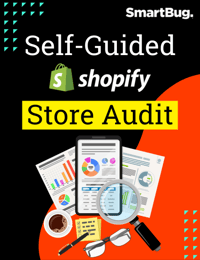
By Kira Renee
Achieving more conversions for e-commerce stores is part art, part science. So many factors impact whether or not customers make it to the finish line.
If conversions aren’t growing, businesses should evaluate the nuances of their customer journeys. The best way to determine what’s causing friction is an e-commerce CRO audit.
Why Does Conversion Rate Optimization Matter?
Every e-commerce business should always be optimizing. The smallest changes can result in significant positive or negative consequences. Experimenting is part of the art-and-science dance. Anything from using higher-quality images to streamlining checkout to improving the mobile user experience (UX) can impact CRO.
For Shopify businesses, the conversion you’re optimizing for is the purchase. Why someone doesn’t buy is a question with millions of answers. Narrowing that large field down to a few is part of conversion rate optimization. Regularly identifying why conversions don’t occur and fixing them leads to more revenue and happier customers.
To begin the journey of CRO for your e-commerce shop, start with an audit.
What Is an E-commerce Conversion Rate Optimization Audit?
An e-commerce CRO audit examines your Shopify website’s UX as it relates to conversions. You’ll assess the buying journey to root out what’s causing people to exit or abandon their shopping carts.
In undertaking an audit, you attempt to address usability and barriers to conversions based on data rather than assumptions. You may identify gaps or issues with design, copy, and user experience. By correcting and improving these things, you can expect to see a bump in conversions, which leads to more predictable revenue generation.
The E-Commerce CRO Process
Every e-commerce brand wants to create an intuitive and positive shopping experience. On the surface, you may think you’ve achieved this—but if conversion rates are low, there might be issues. With a CRO audit, you’re putting on your detective hat to discover the bottlenecks that could be preventing conversions.
Follow these e-commerce CRO audit steps:
Step 1: Assessing Conversion Bottlenecks
At the start, you’ll evaluate possible roadblocks to customer conversions. Most e-commerce brands are familiar with their bottlenecks but don’t know how to measure their impacts.
In a recent webinar, “Improving Sales with a Shopify Site Audit,” our e-commerce experts shared some common conversion blockers. The most concerning is a difficult path to purchase, which occurs due to several factors. Bill Lorimer, AVP of E-Commerce at SmartBug, said, “Technical debt adds up. A company’s initial Shopify site may have been fine a few years ago. Then layers of modifications and updates load on top of each other, causing clutter, and they may not play well together.”
In these cases, slow site loading and bugs within the code can create a poor UX. That spells trouble for conversions.
Along with reviewing user journey flows, dig into activity on conversion pages. Where are people spending time but not converting? Where are they clicking on product pages?
Addressing technical debt is crucial for CRO. Also, look at customer feedback and the questions they ask most. With these insights, you can improve experiences.
Step 2: Crafting a User-Centric Shopping Experience
A user-centric shopping experience based on what your customers want and expect should be the goal of enhancing UX. You’ve already begun to uncover the psychology of the buying experience. Tie in the voice of the customer insights and their digital behavior.
This CRO audit step is continuous as you refine your site to address shifts in consumer expectations.
Step 3: Leveraging Data and User Insights
At this step, you have an array of collected data and metrics, including:
- Heatmaps to provide visual representations of actions on pages
- Conversion rates
- Bounce rates on product pages or checkout
- Checkout page successes and abandonment
- Customer feedback
Your qualitative and quantitative data will tell a story about how satisfied users are shopping on the site and the obstacles present. Then, you’ll start to optimize.
Step 4: Optimizing Product Pages and Checkout Flows
Friction in checkout causes conversion rates to be low. Someone has viewed the product pages and placed items in a cart, but then they bounce. According to a study by the Baynard Institute, the average cart abandonment rate is over 70 percent percent.
If product pages and checkout flows are the culprits, these are the most common reasons and how to fix them:
- Surprise extra costs (e.g., shipping, taxes): Be clear about these fees on the product page. Also, consider offering free shipping to customers who spend a certain amount; this kind of special cost-saving offer can drive more conversions.
- Having to create an account: Creating an account likely offers some benefits, such as discounts or the ability to build a favorites list, but many customers don’t want this hassle. Eliminate it by offering guest checkout.
- Complicated checkout processes with too many fields: Baynard’s data indicates that the average checkout flow has more than 23 elements—much more than the ideal maximum of 12.
- Website errors and crashes: Having the site go down during buying can affect revenue. Continuous stress testing and site improvements can keep downtime at bay.
In addition to these checkout enhancements, make product pages informative and inclusive of social proof. Make sure you’re effectively using images and/or videos, specifications, and customer reviews. The more information you can give buyers, the more confident they’ll be in their purchasing decisions.
Step 5: Implementing A/B Testing Strategies
Experimentation is the next step. A/B testing strategies look at specific conversion moments and create two experiences. Based on the results, you can determine which one drives the most conversions. You can A/B test different options for such elements as:
- Product page experiences, such as video versus static images
- Checkout flows, such as one long page versus a step-by-step process
- Pop-ups for free shipping or a discount to see which one motivates shoppers the most
The intelligence you’ll gain from A/B testing can inform future UX changes.
Step 6: Optimizing the Mobile Experience for CRO
As noted, most e-commerce sales happen on mobile. Your online store is already responsive, but there is always room for improvement. If you see a decline in conversions on mobile, some things to audit include:
- Button sizes: On mobile, UX interactions are by touch, not mouse clicks, so buttons need to be visible.
- Font: Smaller screens need font styles that are easy to read and appropriately sized.
- Form fills: Many e-commerce checkouts provide the correct keyboard when typing in numbers versus letters, which is convenient. Also, many address fields auto-populate as someone types, saving the user time.
The Impact of a Successful E-Commerce CRO Audit
Following the steps we’ve outlined can positively impact your conversion rates. Uncovering conversion blockers is a continuous effort, so plan to conduct audits regularly. The data and insights you’ll gather will reveal much about the customer journey, enabling you to better attract and convert customers.
Get started on your audit with our Shopify Store Self-Guided Audit.
About the author
Kira Renee Kira was formerly our Product Marketing Manager at SmartBug. She believes in a people-first and data-driven marketing approach. Previously working with many reputable brands, building their online brand presence and teaching companies how to enhance their marketing strategy to be customer-centric. When she's not creating a stellar marketing strategy, you can find her enjoying a crisp sour beer surrounded by her hundreds of plants and receiving cuddles from her Labradoodle. Read more articles by Kira Renee.










